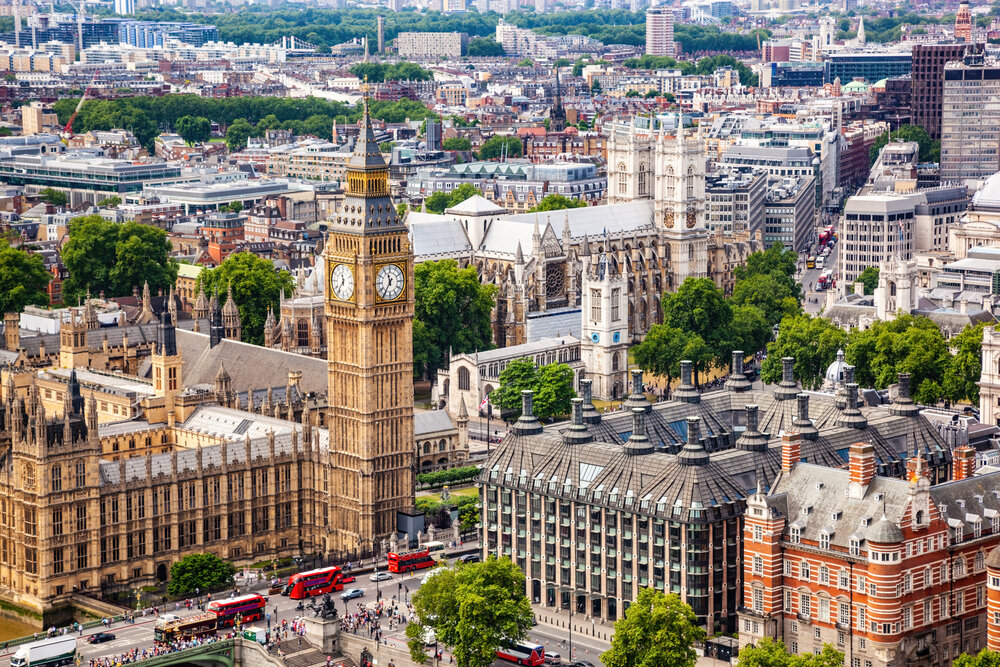As the UK pushes toward Net Zero, cities are transforming into cleaner, greener spaces for people to live and businesses to thrive.
In this guide to the UK’s greenest cities, we spotlight 15 places leading the charge on emissions cuts, air quality improvements, and urban biodiversity.
From cutting air pollution to boosting trees per capita and low-carbon transport, these urban areas are reshaping what a green city looks like.
Discover which city centre innovations are driving the shift and why your next destination might just be one of the top five contenders for the greenest city in Britain.
UK Climate Goals
The UK’s climate goals have fluctuated over the past few decades due to advancing tech, economic pressures, and varying political policies.
In the 1990s, the UK set 1990 as the baseline year for future emissions reductions, with total emissions at 809 million tonnes of CO₂ equivalent. Since then, emissions have fallen by around 48% below that level.
Following the 1997 Kyoto Protocol, the UK set a new target to reduce 12.5% of emissions by 2008–2012, which we hit in 2010 following efforts to phase out coal and boost renewable energy.
In 2008, we agreed to cut emissions 80% by 2050 from the 1990 levels. 17 years in, we have achieved around 60% of this, putting us slightly behind target.
In 2019 the 80% goal was replaced with a 100% net zero target. Transport, heating and energy sectors are seeing the UK’s most significant decarbonisation efforts to date.
In 2021, we pledged to cut emissions 68% by 2030, and today, we are down 48%, making strong progress.
The UK’s current primary goal is to be Net Zero by 2050, requiring immense changes in infrastructure and lifestyle systems in order to achieve a low-carbon, climate-resilient economy.
These early targets laid the foundation for the UK’s current net zero ambitions.
Net Zero by 2050

Following scientific advice, the Climate Change Act in 2008 was set by the UK Parliament to reduce emissions by 80% by 2050.
After years of campaigning, growing public awareness, and scientific consensus, Parliament raised this target in 2019 to Net Zero by 2050 the world’s first legally binding net zero target. This law means future governments are legally obliged to work towards these targets.
The net zero target is pushing UK innovation at scale, showcased by the world-leading offshore wind capacity (the largest in Europe), rapid growth in green hydrogen projects, and significant investment in Carbon Capture and Storage (CCS) tech.
Achieving net zero can transform our economy with green jobs, replacing fossil fuel jobs like coal mining with new roles in renewables, EV manufacturing, and energy efficiency retrofitting. The target will see the rise of circular practices across various sectors, supporting our nationwide sustainable development.
Reducing Emissions
The UK has cut its greenhouse gas emissions by almost half since 1990, placing us amongst the fastest reducers in the race compared to other major economies.
The immense shift of coal dependency from 80% in the mid-1990s to today’s mere 2% has contributed to much of our emission-reducing success. We have transitioned faster than countries like Germany and Poland due to early policy decisions and large investments in renewables.
Clean Energy Transition
The UK’s clean energy transition began in the early 2000s with initiatives like Feed-in Tariffs driving developments in renewable energy, leading us to become a leader in offshore wind by the 2010s.
Other investments, such as £11.5 billion into the nuclear plant at Sizewell C, drive low-carbon energy on a mass scale. Nuclear plants don’t burn anything and provide consistent, reliable power. They have a small footprint, and advanced technologies can reuse fuels.
Transport Decarbonisation
The UK government has committed to banning the sales of new diesel and petrol cars by 2030. Just one petrol car used twice daily on weekdays can account for around 0.5 tonnes of CO2 emissions across a year.
From 2030, purchasing these cars will be banned. Hybrids (combining a diesel or petrol with electric motors) will not be banned until 2035, when only fully electric cars will be able to be purchased in the UK.
While this applies to new vehicles, second-hand vehicles can still be purchased and sold. This means the emission-heavy cars will stay on the roads, eventually phasing out. In time spare parts will be limited, restrictions in low-emission zones will be raised, and maintenance costs could skyrocket in comparison.
Heating and Buildings
Buildings account for a fifth of the UK’s carbon emissions, mainly coming from gas boilers for heating and hot water.
In 2021 the government outlined a Heat and Buildings Strategy, aiming to slash emissions from the 30 million UK homes with plans to upgrade boilers, roll out heat pumps, decarbonise the public sector, and more across the 2020s.
Later in 2023, the Future Homes and Buildings Standards were announced, a set of regulations ensuring new homes are zero carbon or net zero ready.
Since then, a range of other initiatives and funding programmes have supported UK efficient building retrofits and lower emission heating systems.
Nature and Land Use
With biodiversity levels critically falling, the UK has taken on a broad range of targets and goals to ensure species, habitats, and ecosystem health return to thriving levels.
In 2021, a target was set to stop species population declines by 2030, then achieve an increase of 10% by 2042. Efforts underway since have focused on habitat restoration, species monitoring, and protected area management, involving government agencies, conservation groups, and local communities.
The UK’s 30 by 30 target sets out to achieve conservation and management of at least 30% of land and sea by 2030. It was announced in 2021 as part of the Environment Act, and so far has seen progress through protected areas and marine conservation.
Other policies such as Biodiversity Net Gain (BNG) have enforced that development can only continue sustainably, requiring developers to enhance natural habitats.
Carbon Pricing and Regulation
Mandatory carbon markets have existed since 2005 following the launch of the EU ETS, which the UK participated in until leaving the EU in 2021, hence launching the UK ETS.
They exist as a means to legally enforce emission reductions, so that without compliance companies are breaking the law by emitting too much. Before 2005, companies could emit under looser national regulations, without any market-driven penalties.
Now, exceeding limits garners significant penalties such as fines or additional allowance purchases, with severe cases facing operational restrictions.
These carbon pricing and regulatory mechanisms are crucial tools helping the UK drive progress towards net zero by 2050.
Climate Adaptation
Climate adaptation goals are those that prepare the country for the effects of climate change, such as floods, heatwaves, storms, and droughts.
For floods, the UK will invest in flood defences like barriers and embankments. Restoring wetlands, rivers and peatlands allows for natural flood management. There will be less development in flood-prone areas and early warning systems.
For heatwaves, urban cooling strategies will help, as well as public health plans and improved healthcare. Buildings will be made ventilated and cooler.
For storms, power grids are strengthened, as well as transport networks and communication systems. Emergency responses will be able to deal with the disasters effectively.
For droughts, water consumption is being reduced, alongside water-saving tech. Sustainable land management improves moisture retaining soil qualities.
The Criteria Used
Our list of the 15 greenest cities in the UK is based on a thorough range of sustainability criteria including their net zero commitments and the efforts underway.
We’ve selected a range of cities that are transparently showcasing their green initiatives across a broad range of sectors, making immense environmental investments, refreshing outdated systems, restoring natural habitats, and transforming towns into forward-thinking, eco-friendly places to live.
The Greenest Cities in the UK

Cambridge
Cambridge is renowned for the University of Cambridge, situated in the East of England.
They rank second in the UK for commuter cycling, with masses of dedicated cycle lanes, plus abundant parks and green spaces.
Cambridge declared a climate emergency in 2019, aiming for net zero by 2030. They have since been deemed the greenest city, ranked the UK’s most sustainable city in BNP Paribas Real Estate’s Green Cities Index. They boast exceptional green spaces and biodiversity when compared to other green cities.
Exeter
In Devon, the South West, Exeter is known for its historic cathedral and vibrant university city.
The city is known for its green spaces and a mild climate able to support renewables like solar power and wind energy.
They are committed to Net Zero by 2030, with zero-emission bus routes, over 30% green space in the city, and a 2MW battery-backed solar Smart Grid.
Their major goals are to achieve carbon neutrality by 2030, with major efforts underway to achieve this.
Bristol
Also in the South West, Bristol was the first UK city to win the European Green Capital in 2015 thanks to standout green initiatives. It lies just 45 miles east of Cardiff, across the River Severn.
They have rolled out increased tree cover, a 47% reduction in building emissions, a Clean Air Zone, wildlife corridors, and more.
With a primary target of achieving carbon neutrality by 2030, Bristol is well underway.
Oxford
In the South East, Oxford is known for its academic heritage, environmental initiatives, and being surrounded by the Oxford Green Belt, 66,868 hectares of protected countryside preserving natural habitats and farmland.
Targeting net zero by the end of the decade, Oxford leads the UK with 159 electric buses, significantly cutting transport emissions.
It was the first UK city to introduce a Zero Emission Zone (ZEZ), charging non-electric vehicles daily, with fees set to double soon.
Milton Keynes
Milton Keynes is in Buckinghamshire in central England, and boasts more green space per person than all other UK cities.
They place a huge emphasis on Biodiversity Net Gain (BNG), with a broad spectrum of landowners uplifting habitat banks to aid sustainable development. Buckinghamshire also leads in habitat banking, with many local landowners participating in Biodiversity Net Gain (BNG) markets.
View active listings via Gaia’s Marketplace.
Committed to carbon neutrality by 2030, Milton Keynes has planted more than 8,000 trees, retrofitted over 1,500 council homes, and are expanding renewable energy projects.
York
York, located in North Yorkshire just 25 miles northeast of Leeds, is renowned for its rich history and commitment to sustainability.
The city has also set an ambitious target to achieve carbon neutrality by 2030. To meet this goal, York is implementing various green initiatives, including retrofitting council homes, expanding green spaces, and promoting sustainable urban development.
Reading
In Berkshire in the South East, Reading is a well-connected city with thriving parks and rivers, located just 45 miles north of Southampton.
On track to reach net zero emissions by 2030, the city has increased tree canopy cover by 5% and invested heavily in solar energy on public buildings.
Beyond this, they are offering grants for home energy improvements such as insulation and heat pumps, creating expansive cycling and pedestrian zones, and developing a range of pocket parks.
Swindon
In Wiltshire in the South West, Swindon is known for being a rapidly growing urban area, with a mixture of historic and new housing.
They are advancing towards their 2030 carbon neutrality target with extensive tree planting initiatives, solar panels on public buildings, sustainable drainage systems, cycling networks, and more.
16 charge points have been installed for EVs, encouraging sustainable transport and powering their growing electric fleet. Swindon Council operates 14 full EVs and 4 hybrids, with plans to add 13 more.
Gloucester
Also in the South West, Gloucester has a rich historical heritage, surrounded by parks like Robinswood Hill and other natural beauty.
In 2024, Gloucester Cathedral was the very first ancient cathedral to install solar panels, with many more buildings to follow suit.
Striving towards net zero by 2030, primary efforts include increased renewable generation, improved water management, new sustainable developments, and more.
Telford
In Shropshire in the West Midlands, Telford is known for rapid modern growth and industrial heritage.
One of the UK’s “new towns,” designed with planned growth and integrated green spaces, it is surrounded by agricultural land.
In 2023, the city was awarded Tree City of the World by the UN for their urban forestry efforts from 2018 to 2023, leaving the city significantly greener and more resilient.
Beyond this, their 2030 zero carbon goal is being pursued through large-scale retrofitting, clean energy projects, renewables, nature-based solutions, and community engagement.
Manchester
In the North West of England, Manchester was the world’s first industrial city, surrounded by masses of green spaces such as the Irwell Valley.
It’s transitioning into a green economy with over 125,000 trees planted during their City of Trees initiative, and Manchester is also investing £2.5 billion in transitioning to a zero-emission public transport system.
While many other cities’ targets are 2030, Manchester’s target is to hit net zero by 2038, accounting for its larger size, complexity, and industrial legacy.
London
The UK’s capital, London is a leading global city with public transport serving millions a day. London has planted millions of trees through borough initiatives and citywide greening schemes since 2017, and introduced ULEZ to phase out petrol and diesel cars.
London has set targets for net zero carbon emissions by 2030, with efforts in retrofitting, sustainable transport, water efficiency, green infrastructure and much more.
Glasgow
Scotland’s largest city, Glasgow is known for its industrial heritage and shipbuilding. Combining sustainability with modern development, the city is committed to being a Net Zero Carbon City by 2030.
They aim to plant 18 million trees across Glasgow by 2032, with approximately 3 million planted so far.
Over 46% of their households don’t own cars; instead they favour sustainable transport like buses, cycling, and the Glasgow Subway.
Sheffield
In South Yorkshire, Sheffield boasts a rich steel industry heritage alongside the stunning Peak District National Park.
Its abundance of green spaces, woodlands, and parks makes it a beautiful and vibrant university city.
Set to achieve net zero by 2030, Sheffield was awarded Tree City of the World status in 2020 for its urban forestry efforts and is upgrading transport to reduce emissions such as enhancing the Supertram network. Beyond this, the city is expanding cycling infrastructure and promoting energy-efficient housing retrofits.
Edinburgh
The capital of Scotland, Edinburgh is famous for its historic castle, extensive parks, and thriving cultural, political, and academic centre.
With 2030 as its climate target year, the Edinburgh Tram network offers low-emission transport, while investments in energy-efficient buildings and heating schemes continue. Thousands of trees are planted annually.
Beyond this, the city partners with universities and businesses on innovative green projects, such as smart district heating and urban biodiversity initiatives.
More Information
https://www.cambridgeconservatives.org.uk/campaigns/building-greener-affordable-city
https://www.sheffield.ac.uk/news/greenest-city-centres-great-britain-revealed
https://www.endsreport.com/article/1822312/green-cities-index-2023-exeter
https://www.energy.ox.ac.uk/news_items/fantastic-achievement-oxford-named-englands-greenest-city

